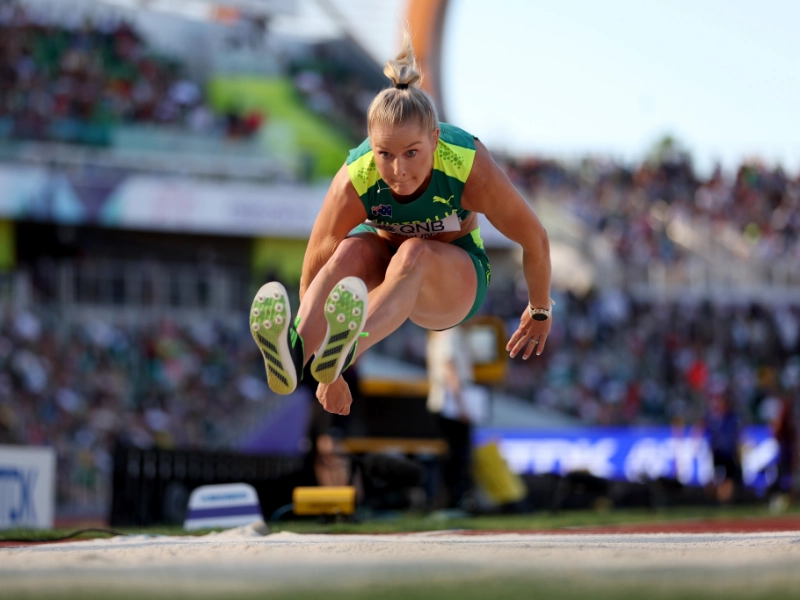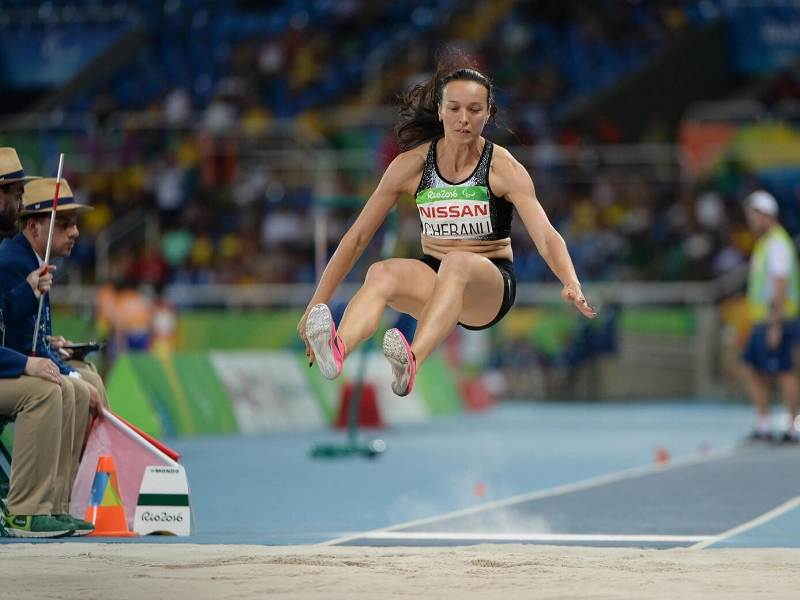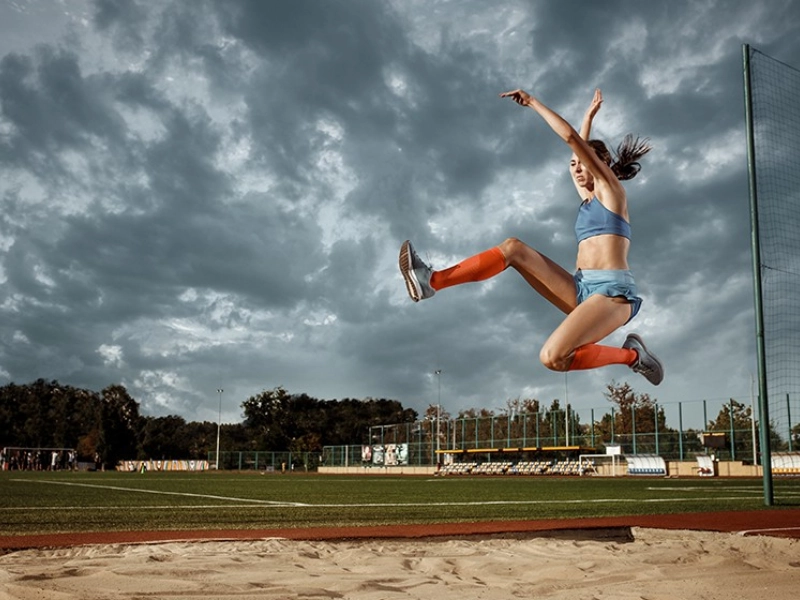A remarkable athletic event combining speed, strength, and skill to reach maximum distance is the long jump. Athletes must become masters in several elements, including the approach, takeoff, flight, and landing phases. Knowing the scientific basis of these methods will enable sportsmen improve their performance and reach personal bests. Focussing on biomechanics, ideal technique, and training programs that support effective jumps, this article will examine the essential components of the long jump.

 Development of the required speed prior to takeoff depends on the approach phase. Usually accelerating and getting ready for the leap, athletes use a sequence of precise strides. An efficient method depends on keeping a constant pace and posture. While driving their knees forward to maximise stride length and frequency, athletes should concentrate on maintaining their body straight.
Using the technique means determining the ideal stride count that fit every athlete's particular style. Before takeoff, most top jumpers count 8 to 12 strides. Athletes should progressively speed as they approach the board, making sure their last few steps are strong and under control. This change into the takeoff phase is absolutely vital since it prepares for a good leap. To build muscle memory and confidence, coaches sometimes stress the need of doing the method constantly.
Development of the required speed prior to takeoff depends on the approach phase. Usually accelerating and getting ready for the leap, athletes use a sequence of precise strides. An efficient method depends on keeping a constant pace and posture. While driving their knees forward to maximise stride length and frequency, athletes should concentrate on maintaining their body straight.
Using the technique means determining the ideal stride count that fit every athlete's particular style. Before takeoff, most top jumpers count 8 to 12 strides. Athletes should progressively speed as they approach the board, making sure their last few steps are strong and under control. This change into the takeoff phase is absolutely vital since it prepares for a good leap. To build muscle memory and confidence, coaches sometimes stress the need of doing the method constantly.
 The magic occurs in the takeoff phase when speed becomes distance. Correct takeoff technique will greatly affect jump performance. Athletes have to concentrate on a few main factors: foot placement, body posture, and time. To best provide force, the takeoff foot should strike the board with a flat foot. One often makes the mistake of landing on the toes, which can cause loss of balance and power.
The athlete should lean slightly forward to keep momentum while extending the takeoff leg as they launch themselves. This movement forward and upward drives the body towards ideal flight. Timing is also crucial; athletes must coordinate the takeoff leg extension with the upward action of their arms to create more lift. Often stressing the takeoff techniques, workouts by coaches help players acquire the required coordination and timing for effective leaps.
The magic occurs in the takeoff phase when speed becomes distance. Correct takeoff technique will greatly affect jump performance. Athletes have to concentrate on a few main factors: foot placement, body posture, and time. To best provide force, the takeoff foot should strike the board with a flat foot. One often makes the mistake of landing on the toes, which can cause loss of balance and power.
The athlete should lean slightly forward to keep momentum while extending the takeoff leg as they launch themselves. This movement forward and upward drives the body towards ideal flight. Timing is also crucial; athletes must coordinate the takeoff leg extension with the upward action of their arms to create more lift. Often stressing the takeoff techniques, workouts by coaches help players acquire the required coordination and timing for effective leaps.
 The flying phase becomes crucial once airborne for keeping momentum and getting ready for landing. To guarantee they maximise distance, athletes should concentrate on their body posture throughout this period. Elite jumpers often adopt the "hurdle" posture, in which case the legs are raised towards the chest. This posture keeps forward motion and helps to reduce drag.
One must keep the arms engaged throughout flight. Athletes can control their body's orientation by means of their arms, therefore establishing balance. Another way to help get ready for landing is to swing the arms downward throughout the descent. Athletes should develop keeping a streamlined posture while in the air since this greatly affects the total distance attained. Knowing the physics of the flying phase helps sportsmen to improve their jumps and technique.
The flying phase becomes crucial once airborne for keeping momentum and getting ready for landing. To guarantee they maximise distance, athletes should concentrate on their body posture throughout this period. Elite jumpers often adopt the "hurdle" posture, in which case the legs are raised towards the chest. This posture keeps forward motion and helps to reduce drag.
One must keep the arms engaged throughout flight. Athletes can control their body's orientation by means of their arms, therefore establishing balance. Another way to help get ready for landing is to swing the arms downward throughout the descent. Athletes should develop keeping a streamlined posture while in the air since this greatly affects the total distance attained. Knowing the physics of the flying phase helps sportsmen to improve their jumps and technique.
Though it is sometimes disregarded, a good long leap depends on the landing phase. To guarantee they maximise the distance recorded, athletes have to pay close attention on their landing. Keeping the body straight, a good landing entails stretching the legs forward. This approach helps one avoid going backward, therefore preventing the loss of important distance. Aiming for land on their feet, athletes should point their toes forward. On landing, this stance helps with control and balance. Moreover, slightly bending the knees upon sand contact helps to distribute the impact and stop injuries. By means of training, practicing landing techniques helps an athlete improve his capacity to execute a successful jump. Many times, coaches stress the need of a properly executed landing to guarantee that every inch of the jump counts.
Athletes who want to thrive in the long jump have to combine several training techniques that improve their whole performance. Since it increases the muscles required for explosive force during takeoff, strength training is absolutely vital. Leg strength and power production can be much enhanced by exercises including squats, lunges, and plyometrics. Including speed training into exercises is also quite vital. Athletes should concentrate on sprinting drills improving top speed and acceleration. Practicing particular long jump drills also helps improve technique in all aspects of the jump. Video analysis is a common recommendation from coaches for evaluating an athlete's form and pointing up areas for development. Strength, speed, and technique training taken together will help athletes create a complete program that best uses their long jump ability.
Though it is sometimes overlooked, the mental component of the long jump is absolutely vital for success. To handle the demands of competition and perform at their best, athletes have to grow to have a strong attitude. Visualisation methods help athletes to mentally practise their jumps and boost their confidence in their own skills. Moreover, emphasising breathing exercises and relaxation can assist lower pre-jump anxiety. Athletes should practise mindfulness to keep present and prevent overanalysing their approach. Creating a pre-jump ritual can also enable sportsmen find rhythm and concentration. Athletes can improve their whole long jump performance by tackling the psychological elements influencing performance.